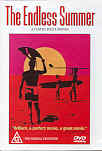
This review is sponsored by

This review is sponsored by
 |
|
|
|
|
|
||
| Category | Documentary | Main Menu Audio & Animation
|
|
| Rating | |||
| Year Released | 1966 | ||
| Running Time | 91:33 Minutes | ||
| RSDL/Flipper | No/No |
|
|
| Start Up | Menu | ||
| Region | 2,4 | Director | Bruce Brown |
|
Distributor |
Warner Vision |
Starring | Robert August
Bruce Brown Mike Hynson |
| Case | Transparent Amaray | ||
| RPI | $39.95 | Music | ? |
|
|
|
||
| Pan & Scan/Full Frame | Full Frame | English (Dolby Digital 1.0, 192Kb/s) | |
| Widescreen Aspect Ratio | None | ||
| 16x9 Enhancement | No | ||
| Original Aspect Ratio | 1.37:1 |
|
|
| Macrovision | Yes | Smoking | No |
| Subtitles | Spanish
French German |
Annoying Product Placement | No |
| Action In or After Credits | No | ||
People who know me outside of the reviewing context are all too aware that I am an avid hater of Summers, with this phase in the climate having an untold nasty effect upon me both biologically and neurochemically. So it is a great achievement of this documentary-drama that not only did I find myself laughing at the narration and soaking up the cinematography, but also that it made me want to travel across the world and visit some of the places shown. As the back cover blurb states "director Bruce Brown creates a film so powerful it has become a timeless masterpiece that continues to capture the imagination of every new generation", and so forth. In spite of having no real plot or dialogue, this documentary about surfing on some of the world's most remote beaches is compelling viewing that even those of us who will never stand on a surfboard in our lives should find fascinating.
Even after thirty-four years, it is easy to see the relevance of the film to modern life. Just listen to the narration about hotel arrangements in the surfers' first stop within Africa, and you'll see what I mean. Regarded as the definitive surfing movie by IMDB users, who have given this film a solid 7.2 out of ten, this is a film that you really have to see at least once. Just make sure you keep well away from any surfing shops for a while after you've done so.
The transfer is presented Full Frame, which I would presume is the way it was intended by the director to be seen, and it is not 16x9 Enhanced.
The transfer doesn't really have that much sharpness on offer, mainly due to the extreme conditions under which it was shot, but everything that the director was aiming to capture is clear and easy to make out. The shadow detail of this transfer is almost non-existent, which is just fine considering that all of the shots are of bright, sunny beaches in the middle of the day. There is no low-level noise in the transfer.
The colour saturation of this transfer is very bright and vivid, often bordering on oversaturation. The manner in which the colours have been captured in this film has really become a cliché, with shots of the sun turning the sea's surface a lovely gold colour present and accounted for, among other things. There is no colour bleeding or chroma noise to worry about, although I was quite tempted to turn the colour control on my television down because of how the skin tones looked.
MPEG artefacts consisted of the very occasional motion compensation artefact that was only really apparent once or twice in the whole film while it was paused or played in slow-motion. Film-to-video artefacts were not a problem in this transfer. There was, however, quite a peppering of film artefacts throughout the feature, with some rather large and nasty-looking black marks frequently visible on the picture. The effect was something like watching a home movie captured on celluloid, so this can be overlooked under the circumstances.
As hard as I searched, I couldn't find any mention of the people responsible for the music in this film, which is a real pity because it is a nice effort. The music lends an atmosphere that seems quite appropriate in spite of how clichéd it has become with the passage of time. Since it is the only other occupant of the soundtrack besides the narration, it comes up sounding rather clear and focused in spite of the monaural transfer.
Being a straight monaural soundtrack, you can forget about any surround or stereo activity in this transfer. While some will lament this lack of discrete channel separation, there is very little in the film that would really benefit from such remixing. The subwoofer was similarly silent throughout the film, only springing into life when I engaged the Mono Movie setting of my amplifier's Pro-Logic mode, and even then it didn't have a lot to do.
The video quality is very good.
The audio quality is serviceable.
There are no extras.
| Video | |
| Audio | |
| Extras | |
| Plot | |
| Overall |
|
|
|
| DVD | Toshiba SD-2109, using S-video output |
| Display | Samsung CS-823AMF (80 cm) in 16:9 and 4:3 modes, calibrated using the NTSC DVD version of Video Essentials. |
| Audio Decoder | Built In (Amplifier) |
| Amplification | Sony STR-DE835, calibrated using the NTSC DVD version of Video Essentials. |
| Speakers | Yamaha NS-45 Front Speakers, Yamaha NS-90 Rear Speakers, Yamaha NS-C120 Centre Speaker, JBL Digital 10 Active Subwoofer |